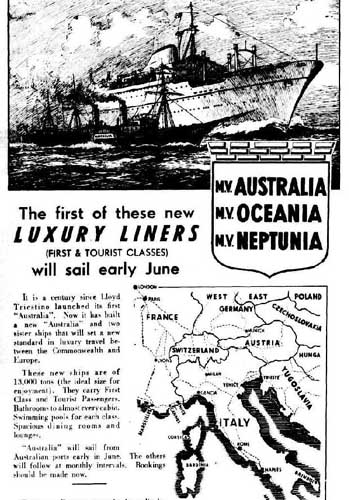
Lloyd Triestino's shipping fleet, like many of those operated by Italian companies suffered great losses during World War Two. Recovery after the war was slow, operating with older, 'second-hand' vessels until resources became available to add new ships to the fleet. The Australia run was being operated by the Sebastiano Cabato, Ugolino Vivaldi and Toscana prior to the delivery of the new vessels. The MV Australia was the first of seven similar ships added to the Lloyd Triestino fleet, with the first three for use on the Australia service. The seven ships were:
Australia, Oceania & Neptunia: built 1951 for the Australian service.
Africa & Europa: built 1952 for the African service.
Asia & Victoria: built 1953 for the Asian service.
When delivered they were 12,838 gross tons with a service speed of 18 knots. Air conditioning was available in the public spaces whilst forced ventilation was provided in the cabins. First class passengers totalled 120 whilst the tourist class comprised two levels of comfort, regular tourist class cabins could accommodate 280 passengers whilst a further 392 utilised dormitory style accommodation. The latter allowed immigrant travellers to use the tourist class public facilities but at a lower cost, closer to what third class might have been.
The first sailing for the Australia was from Genoa to Australia during February/March 1951. The ship was due at Brisbane on May 25th 1951. Master of the ship was Captain Francesco Albanese. The first westbound trip departed June 7th from Melbourne. The second trip from Europe arrived Sydney about August 11th with departure from Sydney expected August 15th at 5pm. All visitors were required to be off the ship by 4.15pm. Heavy baggage for the hold was to be received no later than noon the previous day. For the westbound sailing, about September 6th to Naples & Genoa via Colombo and Bombay, fares were advertised as: First class: £135-£200 stg, Tourist class: £65-£105 stg, with return bookings guaranteed.
February 16th 1952: departed Sydney for Europe.
December 26th 1952: the Australia took a one day 'Boxing Day' cruise to follow the start of the Sydney - Hobart yacht race. Passengers on this cruise paid £6 a head to travel in the luxury liner, which cost £1,700 to take to sea for the day; the proceeds were to assist newly arrived Italian migrants. The cruise travelled about sixty miles down the coast, encountering a stormy squall, which turned many passengers 'green', the good weather soon returned, and the ship was back at Sydney by 10pm. Captain Achille Donda was in charge of the ship.
March 14th 1953: departed Sydney for Europe.
Ports of call for the April 1953 - December 1953 timetable were: Genoa, Naples, Messina, Port Said, Suez, Aden, Colombo, Fremantle, Melbourne, Sydney. The return sailing also called at Djakarta, this would later become a permanent port of call.
January 1954: a report of one 'immigrant' eastbound sailing from Genoa to Sydney revealed a passenger list including 849 immigrants, comprised of eighteen nationalities and 140 'stateless' persons, or 'Apolidi' as described by the Italian authorities at Genoa. The 849 persons included 286 children, 354 women which included a contingent of expectant mothers. A Greek family lost the husband whilst crossing the Indian Ocean, his body being taken ashore at Djakarta for burial. The wife and two children continued on to Sydney. As if to make up the loss, an expectant mother gave berth between Melbourne & Sydney.
Approximate departure dates from Sydney for the Australia: January 16th 1954 & April 3rd 1954.
For the Australia's sailings about September 7th 1954 & November 24th 1954 the fares offered to Italy were £147-£212 stg with an Excursion return fare of £200-£280 stg, with most cabins at these fares having a private shower, or bath, and toilet.
The ships configuration were altered during refits carried out in 1959. First class accommodation was increased to 136 whilst tourist class increased to 536 following the removal of the dormitories. Air conditioning was made available throughout the ship. Gross tons increased slightly to 13,140.
Ports of call for the Australia during the 1960 timetable included Genoa, Naples, Messina, Port Said, Suez, Aden, Colombo, Cochin, Singapore, Djakarta, Fremantle, Melbourne & Sydney.
Another four years were spent on the Australia service, but age was catching up to the Australia and her sisters, as well as increasing demand on the route. Lloyd Triestino commissioned two new larger and faster ships, the Galileo Galilei & Guglielmo Marconi, both being introduced on the Australia service during 1963. The Australia, Oceania & Neptunia were then transferred to the Italia Line (Italia Societa per Azioni di Navigazione) and renamed Donizetti, Verdi & Rossini respectively. They commenced operation on the Genoa - Panama - Valparaiso route to the west coast of South America.
The Donizetti was scrapped by Cantieri Navali del Golfo at La Spezia, Italy during 1977.
Basic Details
Built: Cantieri Riuniti dell'Adriatico, Trieste, Italy in 1951
Tonnage: 12,838 / 13,140 gross tons
Length: 161.1 meters
Beam: 21.1 meters
Draught: ??
Propulsion: two CRA Sulzer ten-cylinder engines totalling 14,500bhp
Screws: ??
Speed: 18 knots

Resources:
National Library of Australia : Trove website of archived Australian Newspapers (trove.nla.gov.au)
TROVE page 9 'mv australia'.
Page added April 20th 2011
Last updated November 16th 2014
Return to Ship menu
Return to site menu